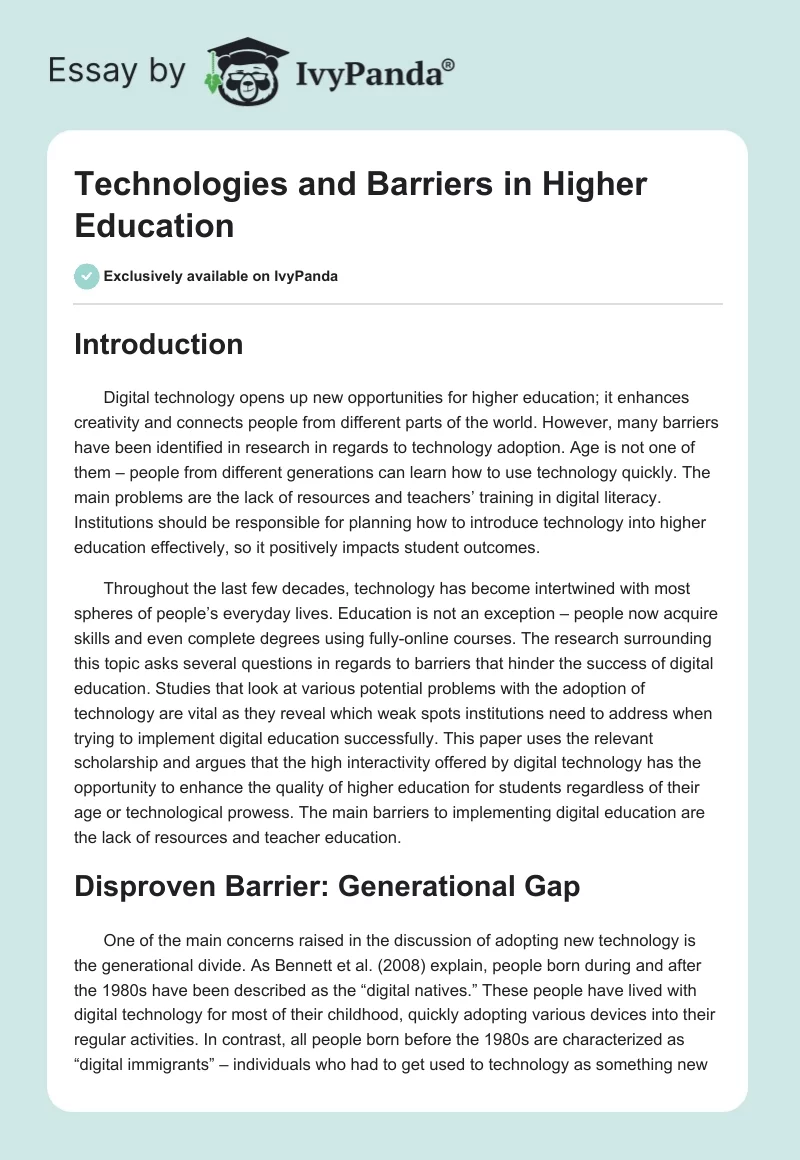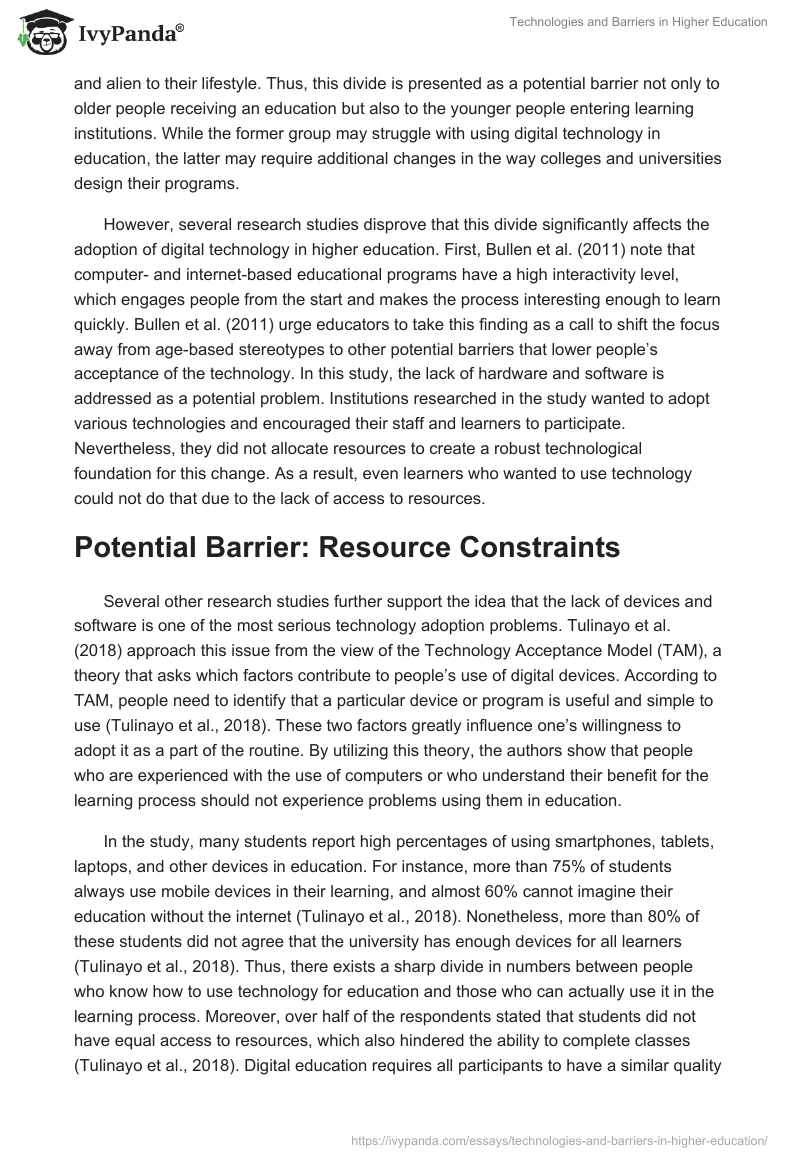Introduction
Digital technology opens up new opportunities for higher education; it enhances creativity and connects people from different parts of the world. However, many barriers have been identified in research in regards to technology adoption. Age is not one of them – people from different generations can learn how to use technology quickly. The main problems are the lack of resources and teachers’ training in digital literacy. Institutions should be responsible for planning how to introduce technology into higher education effectively, so it positively impacts student outcomes.
Throughout the last few decades, technology has become intertwined with most spheres of people’s everyday lives. Education is not an exception – people now acquire skills and even complete degrees using fully-online courses. The research surrounding this topic asks several questions in regards to barriers that hinder the success of digital education. Studies that look at various potential problems with the adoption of technology are vital as they reveal which weak spots institutions need to address when trying to implement digital education successfully. This paper uses the relevant scholarship and argues that the high interactivity offered by digital technology has the opportunity to enhance the quality of higher education for students regardless of their age or technological prowess. The main barriers to implementing digital education are the lack of resources and teacher education.
Disproven Barrier: Generational Gap
One of the main concerns raised in the discussion of adopting new technology is the generational divide. As Bennett et al. (2008) explain, people born during and after the 1980s have been described as the “digital natives.” These people have lived with digital technology for most of their childhood, quickly adopting various devices into their regular activities. In contrast, all people born before the 1980s are characterized as “digital immigrants” – individuals who had to get used to technology as something new and alien to their lifestyle. Thus, this divide is presented as a potential barrier not only to older people receiving an education but also to the younger people entering learning institutions. While the former group may struggle with using digital technology in education, the latter may require additional changes in the way colleges and universities design their programs.
However, several research studies disprove that this divide significantly affects the adoption of digital technology in higher education. First, Bullen et al. (2011) note that computer- and internet-based educational programs have a high interactivity level, which engages people from the start and makes the process interesting enough to learn quickly. Bullen et al. (2011) urge educators to take this finding as a call to shift the focus away from age-based stereotypes to other potential barriers that lower people’s acceptance of the technology. In this study, the lack of hardware and software is addressed as a potential problem. Institutions researched in the study wanted to adopt various technologies and encouraged their staff and learners to participate. Nevertheless, they did not allocate resources to create a robust technological foundation for this change. As a result, even learners who wanted to use technology could not do that due to the lack of access to resources.
Potential Barrier: Resource Constraints
Several other research studies further support the idea that the lack of devices and software is one of the most serious technology adoption problems. Tulinayo et al. (2018) approach this issue from the view of the Technology Acceptance Model (TAM), a theory that asks which factors contribute to people’s use of digital devices. According to TAM, people need to identify that a particular device or program is useful and simple to use (Tulinayo et al., 2018). These two factors greatly influence one’s willingness to adopt it as a part of the routine. By utilizing this theory, the authors show that people who are experienced with the use of computers or who understand their benefit for the learning process should not experience problems using them in education.
In the study, many students report high percentages of using smartphones, tablets, laptops, and other devices in education. For instance, more than 75% of students always use mobile devices in their learning, and almost 60% cannot imagine their education without the internet (Tulinayo et al., 2018). Nonetheless, more than 80% of these students did not agree that the university has enough devices for all learners (Tulinayo et al., 2018). Thus, there exists a sharp divide in numbers between people who know how to use technology for education and those who can actually use it in the learning process. Moreover, over half of the respondents stated that students did not have equal access to resources, which also hindered the ability to complete classes (Tulinayo et al., 2018). Digital education requires all participants to have a similar quality of devices in order to complete assignments. Thus, it is acceptable to expect that the institutions include resource allocation into their plan of digitalization.
Potential Barrier: Teachers’ Knowledge
Another barrier to the adoption of digital technology n higher education is teachers’ computer skills and their desire to implement new learning strategies into the students’ curriculum. Notably, this problem is also connected to the way in which schools prepare for their education to change in the digital age. According to Mercader and Gairín (2020), professional and institutional barriers are the most prevalent in education, especially in arts and humanities. Here, the authors dispute the idea that learners are the source of non-acceptance. This finding is supported by previous studies; it suggests that learners of any age and skills can use technology effectively, but only if their teachers and institution give them a chance to do so.
Digital technology implies that teachers will not only disseminate knowledge with the help of devices and special software. It also provides educators with an opportunity to modify learning strategies, implement interactive exercises, and increase students’ creativity. In fact, it is found that students’ creative output can be significantly improved through the use of various programs (Jahnke & Liebscher, 2019). Therefore, one should look for another barrier that permits students from using digital technology in highly creative areas, such as humanities and arts. As noted above, Mercader and Gairín (2020) find the lack of education for teachers to be a problem. Although institutions introduce plans to implement technology, they often focus not on creating strategies but on technical training. For example, educators may receive knowledge about how to operate a device, but they lack an understanding of digital literacy.
Recommendations for Change: The Role of Institutions
The adoption of technology greatly depends not on one’s personal characteristics but systemic implementation, resource allocation, and strategizing. People can benefit from technology in education, regardless of whether they were born as a part of the digital natives’ generation or not. Subsequently, age does not play a role in learning how to use computers for education in both students and teachers. Many students use digital technology to communicate with one another and with educators. They also find the use of smartphones and other devices beneficial to reaching their learning goals. It is found that creativity is heightened when learners apply their skills on platforms that appropriately use the opportunities of digital technology.
It is vital to consider the reason behind the technology being underutilized in higher education. Both factors considered in this paper – lack of resources and inadequate training – can be linked to institutions’ failure to plan for a future of digital education. As researchers find, students and teachers cannot effectively utilize technology if they do not have equal access to it. Similar to non-digital methods, people with insufficient resources do not get the same opportunities for learning. For instance, if a medical college does not have models on which students can practice, it does not provide its learners with practical knowledge that other institutions may give. One can compare this lack of resources to the one in digital education. If a school does not introduce an online-platform that all students can access, it cannot unite all learners and achieve successful digitalization.
In the same way, teachers who understand how to use a computer but do not know which creative opportunities it holds cannot effectively improve the curriculum for digital learning. Lesson planning greatly influences students’ engagement and their subsequent quality of participation (Bullen et al., 2011). Institutions should take a strategic approach and review which types of training are necessary for educators to receive to create diverse programs.
Thus, a question arises of how colleges can undertake digitalization to contribute to the integration of digital technology in education. A study by Jahnke and Liebscher (2019) is an example of how universities can approach this planning step. In it, scholars demonstrate how mobile devices can be used in a variety of disciplines to inspire creativity, engagement, discussion, and learning. In some cases, communication plays a vital role, while in others, it is essential for students to use technology in the real world and learn how to ask questions. However, students and teachers alone cannot adequately prepare themselves for the use of digital technology. Institutions should consider the impact of digitalization and take action to improve their planning.
Conclusion
Overall, one can see that digital technology has dramatically influenced all parts of human life, including education. Virtual classes and online-based platforms have been integrated into the students’ curriculum. However, many barriers still exist for this technology to make a meaningful impact. The most prominent issues are the lack of resources and teachers’ inadequate training. To overcome these problems, institutions should carefully plan the adoption of technology and acknowledge that they need to allocate resources to both students and teachers.
References
Bennett, S., Maton, K., & Kervin, L. (2008). The ‘digital natives’ debate: A critical review of the evidence. British Journal of Educational Technology, 39(5), 775-786. Web.
Bullen, M., Morgan, T., & Qayyum, A. (2011). Digital learners in higher education: Generation is not the issue.Canadian Journal of Learning and Technology, 37(1), 1-25. Web.
Jahnke, I., & Liebscher, J. (2019). Three types of integrated course designs for using mobile technologies to support creativity in higher education. Computers & Education, 146(1), 1-12. Web.
Mercader, C., & Gairín, J. (2020). University teachers’ perception of barriers to the use of digital technologies: The importance of the academic discipline.International Journal of Educational Technology in Higher Education, 17(1), 1-14. Web.
Tulinayo, F. P., Ssentume, P., & Najjuma, R. (2018). Digital technologies in resource constrained higher institutions of learning: A study on students’ acceptance and usability.International Journal of Educational Technology in Higher Education, 15(1), 36. Web.


